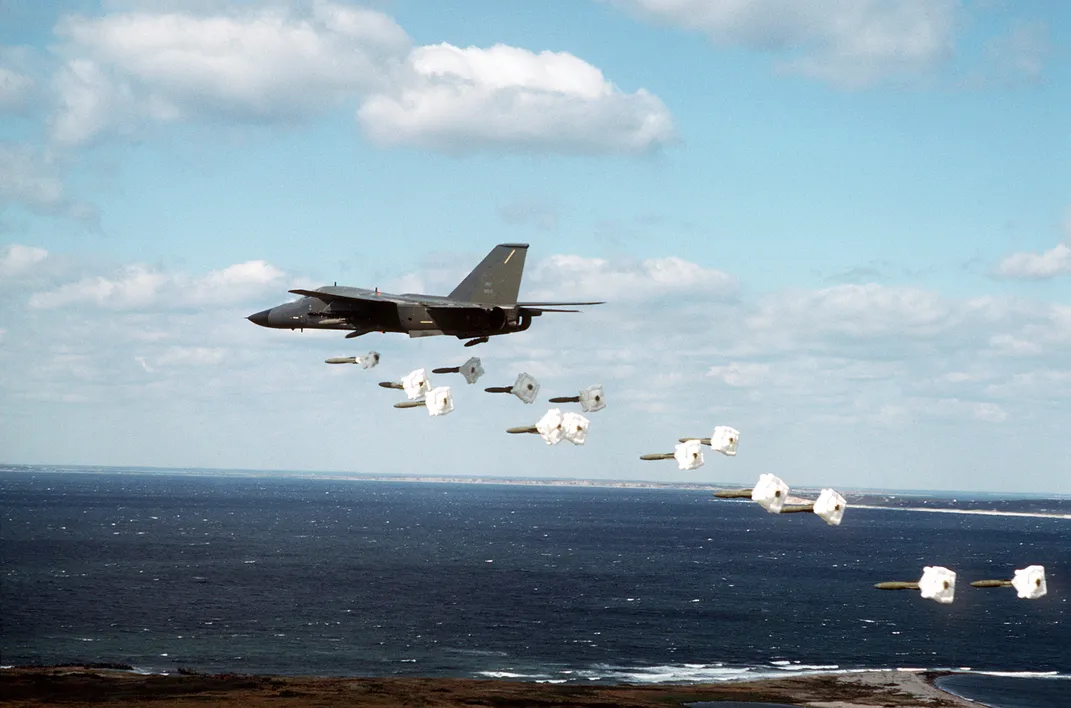This Uninhabited Island Off of Massachusetts Is Littered With Bombs
Whether wildlife refuge, research destination or restored traditional homeland, the fate of Nomans Land is up for debate
/https://tf-cmsv2-smithsonianmag-media.s3.amazonaws.com/filer/b4/79/b479ae20-b4bb-4e73-931e-2bdc48a56dbe/nomans_land_massachusetts.jpg)
Nomans Land, Massachusetts, is unusual for the heavily populated New England coast. The island could have ended up like a miniature version of Martha’s Vineyard—the upscale vacation destination that sits just five kilometers to the north. Instead it’s brimming with spotted turtles and myriad migratory birds—a de facto wildlife sanctuary with little human presence. And there’s a good reason for that: from 1943 to 1996, the island served as a bombing range for the US Navy. In spite of previous cleanup efforts, Nomans Land remains littered with unexploded explosive ordnance (UXO) that has rendered it closed to the public.
But despite half a century of destruction, life has flourished on the island. And now, area residents are embroiled in a question that is at once philosophical and practical: what to do with Nomans Land.
Gus Ben David, a naturalist, biologist, and third-generation Martha’s Vineyard resident first visited Nomans Land in 1973, when he was sent by the local newspaper to report on the state of the island. He has spent more time there than any other civilian, and today is championing the view that the island should be left alone. Nomans Land has become a paradise for wildlife unbothered by humankind, Ben David says. If the remaining ordnance doesn’t harm the wildlife, then it poses no problem, he says, and any further attempts to remove the unexploded weapons could jeopardize the habitat.
“Wildlife is a product of habitat,” Ben David says. “You protect the habitat, and you have your wildlife.”
But there are those who want to see a renewed effort to clean up the island. Some hope to eventually be able to set foot on the picturesque spot. Others are worried that unexploded bombs could find their way to sea and wash up on nearby Martha’s Vineyard.

Brian McCarty, an ecologist, US Air Force veteran, and fishing guide, thinks the island needs to be cleaned up. He’d like to see the island opened to limited visitors—for research and for community members to reconnect with it. “You don’t manage anything by leaving it alone entirely and not having a connection to it,” he says.
But his motivation also stems from a more pragmatic concern. While the potential for the UXOs to explode is valid, he’s more concerned that corroding munitions could pollute the soil and groundwater. McCarty explains that the only fresh water on Martha’s Vineyard, where he lives, comes from the same aquifer that underlies Nomans Land. Anything that corrodes in the soil on Nomans Land, he says, will end up contaminating the water on Martha’s Vineyard.
Beyond ecological or public health concerns, there are serious cultural concerns that must be taken into account when discussing what to do with the island.
While the origin of the name Nomans Land is disputed, one explanation is that a Wampanoag leader named Tequenoman once had domain over the island—that is, Tequenoman’s land. What isn’t disputed, however, is that his people, the Wampanoag Tribe of Gay Head, lived there long before it was a bombing range.
As reported in the Vineyard Gazette, Bret Stearns, speaking on behalf of the tribe at a public hearing, said the Wampanoags want “greater and safer access to the island, both for cultural use, and for general access by tribal members.”
The opinions of those engaged in the public debate about what to do with Nomans Land are varied and passionately held, says Alex Bushe, a documentary filmmaker working on a project about the island. “I think that there are good arguments from all sides. It’s a really, really tough call.”
There is allure to the idea of leaving the island to nature—freeing it of human footprints and influence. There is a logical impulse to clean up humanity’s mess, to manage the island and connect with it. There is a duty to return the land to those who lived there long before any bombs were dropped. What remains unclear is if, how, or when, all parties can arrive at a consensus.
This article is from Hakai Magazine, an online publication about science and society in coastal ecosystems. Read more stories like this at hakaimagazine.com.
Related stories from Hakai Magazine:
Why Ocean Shores Beachcoming Is a Blast
Weapons of War Litter the Ocean Floor
Planning Your Next Trip?
Explore great travel deals
Smithsonian magazine participates in affiliate link advertising programs. If you purchase an item through these links, we receive a commission.